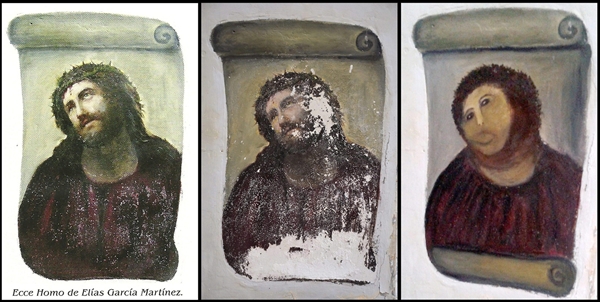

What started out as a good-intentioned touch-up of a 100 year old painting inside a church near Zaragoza, Spain turned out to be, to put it nicely, quite the poorly done “restoration” of the work of art feature Jesus himself.
Entertainment on Today writes:
Would you think to match your home-grown painting skills against a classical artist? Probably not, but that’s just what a well-intentioned woman in her 80s did recently in Spain.
The three photos above tell the tale. The image on the left is the original work, a century-old oil painting of Christ called “Ecce Homo (Behold the Man)” that was painted on a column inside a church near Zaragoza, Spain, by artist Elias Garcia Martinez.
Over the years, the work began to deteriorate, as shown in the second image. According to the Centre de Estudios Borjanos, the unnamed amateur artist (without permission from the church, needless to say) thought she could improve the work and set to work with paints and brushes. The third picture is the result.
The BBC reports that the woman realized her mistake and contacted Juan Maria Ojeda, a city council member in charge of cultural affairs for the area. “I think she had good intentions,” Ojeda told the BBC.
A team of art restoration experts is reportedly examining the painting, will quiz the woman on what materials she used in her attempt, and will figure out how best to proceed.
Read more at todayentertainment.today.com

